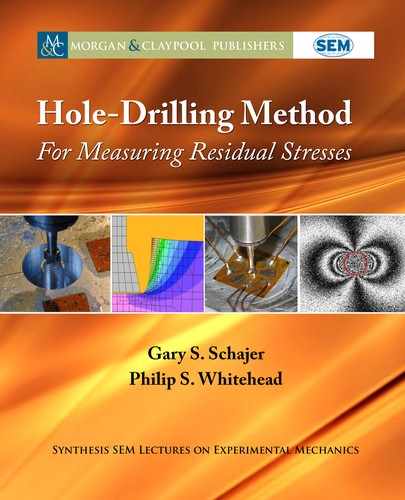62 3. HOLE-DRILLING METHOD CONCEPT AND DEVELOPMENT
used only for measuring residual stresses up to about 60% of the yield stress, or to 80% if the hole
depth is limited to about half its diameter, as specified in the 2013 revision of ASTM E837.
e greater stress capacity at smaller hole depths occurs because the material below the cut hole
reinforces the surrounding material and reduces the stress concentration effect of the hole.
e advent of optical methods for measuring the deformations about the drilled hole
created new computational challenges because of the large quantity but relatively low quality
of the available data. Early computational procedures tended to follow strain gauge practice.
Displacement data were selected from a small number of hypothetical strain gauge locations
within the overall measurement area and then used with the established strain gauge equations to
determine stresses. In some cases, such as shown in Figure 3.11, the specific areas corresponding
to standard strain gauge rosette designs were chosen so that the associated calibration data could
be used.
Later computational approaches sought to take advantage of the large number of data
available from optical measurements, often running into the millions. ese data can be aver-
aged using various techniques so as to reduce the effect of measurement noise and to improve
overall measurement quality. e data can also be analyzed to derive quantities other than the
three in-plane stresses. Notably, artifacts due to thermal effects, bulk displacements, rotations
and scale changes can be identified and separated out. e latter separations are particularly im-
portant when doing microscopic measurements because small fluctuations in image settings are
inevitable and will cause significant deviations if not compensated.
Development of computational procedures remains an active and productive area of de-
velopment of the Hole-Drilling Method, stimulated in large part by the ever improving acces-
sibility to sophisticated finite element software and by the interesting opportunities presented
by the rich data available from optical measurements. e challenge is to create straightforward
procedures that are compact and practical and can be used by a wide cross-section of practition-
ers.
3.9 CONCLUDING REMARKS
e Hole-Drilling Method for measuring residual stresses has grown and developed substan-
tially since the pioneering work of Mathar. e technique has become well established, with
its own ASTM Standard Test Procedure. e Hole-Drilling Method continues to advance ac-
tively in all three of its main aspects: hole-drilling, deformation measurement and computational
methods. Recent work has concentrated on the use of full-field optical techniques to measure
the deformations around a drilled hole. ese developments have greatly expanded the scope of
hole-drilling residual stress measurements, notably by providing a very rich source of available
data suitable for further analysis and evaluation.
Mathar’s foundational idea to use the deformations around a drilled hole to evaluate ma-
terial residual stresses has proven to be a very fertile one. Nearly a century of active research and
application has followed his pioneering work. Unfortunately, the early death of Mathar pre-
..................Content has been hidden....................
You can't read the all page of ebook, please click here login for view all page.
